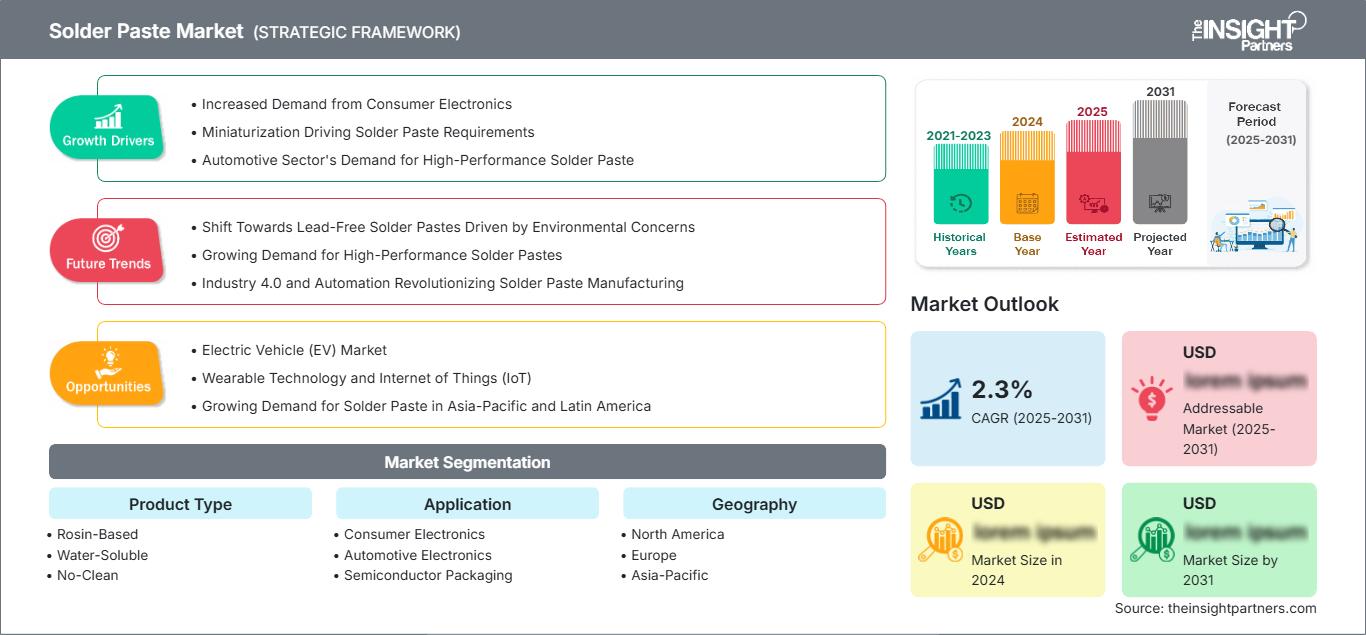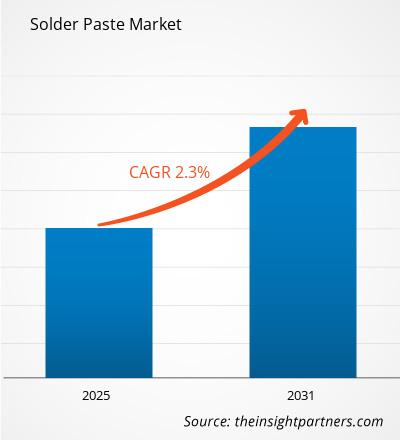Der Markt für Lötpasten wird voraussichtlich zwischen 2025 und 2031 eine durchschnittliche jährliche Wachstumsrate (CAGR) von 2,3 % verzeichnen, wobei die Marktgröße von XX Millionen US-Dollar im Jahr 2024 auf XX Millionen US-Dollar im Jahr 2031 anwachsen wird.
Der Bericht ist nach Produkttyp segmentiert (kolophoniumbasiert, wasserlöslich und No-Clean). Der Bericht präsentiert außerdem eine Analyse basierend auf der Anwendung (Unterhaltungselektronik, Automobilelektronik, Halbleiterverpackungen und andere). Der Bericht umfasst fünf Regionen: Nordamerika, Europa, Asien-Pazifik, Naher Osten und Afrika sowie Süd- und Mittelamerika und die wichtigsten Länder jeder Region. Die globale Analyse ist weiter auf regionaler Ebene und nach den wichtigsten Ländern aufgeschlüsselt. Der Bericht bietet den Wert in USD für die obige Analyse und Segmente.
Zweck des Berichts
Der Bericht „Lötpastenmarkt“ von The Insight Partners zielt darauf ab, die aktuelle Situation und das zukünftige Wachstum sowie die wichtigsten treibenden Faktoren, Herausforderungen und Chancen zu beschreiben. Dies bietet verschiedenen Geschäftspartnern Einblicke, wie beispielsweise:
- Technologieanbieter/-hersteller: Um die sich entwickelnde Marktdynamik zu verstehen und die potenziellen Wachstumschancen zu kennen, damit sie fundierte strategische Entscheidungen treffen können.
- Investoren: Um eine umfassende Trendanalyse hinsichtlich der Marktwachstumsrate, der finanziellen Marktprognosen und der Chancen entlang der Wertschöpfungskette durchzuführen.
- Regulierungsbehörden: Um Richtlinien und Überwachungsaktivitäten auf dem Markt zu regulieren, mit dem Ziel, Missbrauch zu minimieren, das Vertrauen der Investoren zu wahren und die Integrität und Stabilität des Marktes aufrechtzuerhalten.
Lötpasten-Marktsegmentierung: Produkttyp:
- Kolophoniumbasiert:
- Wasserlöslich:
- No-Clean:
Anwendung:
- Unterhaltungselektronik:
- Automobilelektronik:
- Halbleiterverpackungen:
Sie erhalten kostenlos Anpassungen an jedem Bericht, einschließlich Teilen dieses Berichts oder einer Analyse auf Länderebene, eines Excel-Datenpakets sowie tolle Angebote und Rabatte für Start-ups und Universitäten.
Markt für Lötpasten: Strategische Einblicke

- Holen Sie sich die wichtigsten Markttrends aus diesem Bericht.Dieses KOSTENLOSE Beispiel umfasst Datenanalysen, die von Markttrends bis hin zu Schätzungen und Prognosen reichen.
Wachstumstreiber für den Lötpastenmarkt
- Steigende Nachfrage aus der Unterhaltungselektronik: Die gestiegene Nachfrage nach Unterhaltungselektronik, darunter Smartphones, Laptops und Wearables sowie andere intelligente Geräte, ist der wichtigste Wachstumsfaktor für den Lötpastenmarkt. Lötpaste ist ein wichtiges Material in der Oberflächenmontagetechnik (SMT) zur Montage dieser Geräte. Die wiederauflebende Halbleiterindustrie treibt die Nachfrage weiter an, da sie Lötpaste für die effiziente und zuverlässige Montage von Chips und anderen Komponenten verwendet. Da Unterhaltungselektronik dank fortschrittlicherer Technologien immer kleiner und kompakter wird, steigt die Nachfrage nach hochwertiger Lötpaste zur Erhöhung der Präzision und Zuverlässigkeit bei der Platzierung der Komponenten.
- Miniaturisierung treibt den Bedarf an Lötpaste: Die Miniaturisierung in der Elektronikindustrie ist ein weiterer wichtiger Trend, der den Lötpastenmarkt vorantreibt. Da Siliziumgeräte immer kleiner und leistungsfähiger werden, benötigen die Hersteller Lötpaste mit feinerer Partikelgröße und besseren Eigenschaften für die Montage kleiner, effizienter Einheiten für ihre Komponenten. Dasselbe gilt für eine große Anzahl von Smartphones, Wearables und IoT-Produkten, die miniaturisierte Komponenten erfordern. Lötpaste mit fein abgestimmter Zusammensetzung spielt eine entscheidende Rolle bei hochdichten Verbindungen für kleinere Geräte und Leiterplatten.
- Nachfrage der Automobilbranche nach Hochleistungslötpaste: Zu den treibenden Faktoren in der Automobilbranche zählen Komplexität und zunehmende Abhängigkeit von Elektronik durch Elektrofahrzeuge, autonomes Fahren und fortschrittliche Fahrerassistenzsysteme; daher steigt die Nachfrage nach Lötpaste. Automobilelektronik erfordert hochzuverlässige, langlebige Lötverbindungen für kritische Anwendungen wie Sensoren, Steuergeräte und Leistungselektronik. Der höhere Elektronikanteil in modernen Fahrzeugen, insbesondere in Elektro- und Hybridfahrzeugen, erhöht weiterhin den Bedarf an Hochtemperatur-Lötpasten, die solchen Bedingungen über lange Zeiträume standhalten können – ein wichtiger Treiber des Marktwachstums.
Zukünftige Trends im Lötpastenmarkt
- Umstellung auf bleifreie Lötpasten aufgrund von Umweltbedenken: Umweltbedenken und der regulatorische Druck der RoHS-Richtlinie (Restriction of Hazardous Substances) der Europäischen Union haben die Industrie dazu veranlasst, sich deutlich von bleihaltigen Lötpasten zu entfernen und diese durch bleifreie zu ersetzen. Bleifreie Lötpasten, hauptsächlich basierend auf Legierungen wie Zinn-Silber-Kupfer (SAC), werden zunehmend zum neuen Standard in der Elektronikfertigung. Die Einhaltung von Umweltvorschriften und ein wachsendes Augenmerk auf Nachhaltigkeit treiben diesen Trend voran. Bleifreie Lötpasten bieten außerdem Vorteile wie eine verbesserte Leistung bei Temperaturwechselbeanspruchung sowie eine höhere mechanische Festigkeit und eignen sich daher für eine Vielzahl von elektronischen Anwendungen.
- Steigende Nachfrage nach Hochleistungs-Lötpasten: Angesichts der hohen Komplexität elektronischer Geräte steigt die Nachfrage nach Hochleistungs-Lötpasten mit herausragenden Eigenschaften wie High-Pitch-Fähigkeit, hoher thermischer Stabilität und schnellen Reflow-Zeiten. Heute sind Lötpasten höherer Qualität gefragt, die Zuverlässigkeit in Anwendungen mit feineren Bauteilen in kleinster und hochentwickelter Elektronik gewährleisten, beispielsweise in Smartphones, medizinischen Geräten und der Automobilelektronik. Diese Anforderungen treiben die Innovation bei Lötpastenformulierungen voran: hervorragende Benetzung, geringe Voidbildung und gute Flussmittelaktivität.
- Industrie 4.0 und Automatisierung revolutionieren die Lötpastenherstellung: Die Prinzipien von Industrie 4.0, gepaart mit dem stärkeren Einsatz von Automatisierung in SMT-Produktionslinien (Surface Mount Technology), bestimmen den Lötpastenmarkt. Der automatisierte Lötpastendruck sowie verbesserte Qualitätskontrollsysteme ermöglichen mehr Genauigkeit, weniger Defekte und einen gleichmäßigen Lötpastenauftrag. Dies wiederum wird Hersteller dabei unterstützen, ihre Produktionsprozesse zu optimieren, den Durchsatz zu erhöhen und Kosten zu senken. In SMT-Linien integrierte Sensoren und Echtzeit-Überwachungssysteme ermöglichen einen präziseren Lotpastenauftrag. Bei der Massenproduktion wird die Ausbeute verbessert und der Abfall reduziert.
Marktchancen für Lotpaste
- Markt für Elektrofahrzeuge (EV): Eine wichtige Wachstumschance für den Lotpastenmarkt: Der Boom der Elektrofahrzeuge ist eine riesige Chance für den Lotpastenmarkt. Die weite Verbreitung von Elektrofahrzeugen erhöht die Nachfrage nach elektronischen Komponenten, die im Automobilsektor robust und leistungsstark sein müssen. Elektrofahrzeuge verwenden eine große Anzahl elektronischer Systeme für Batteriemanagement, Leistungselektronik, Wechselrichter, Sensoren und ADAS-Funktionen, die effiziente und hochzuverlässige Lötverbindungen erfordern. Dies ermöglicht Lotpastenherstellern, hochzuverlässige und temperaturempfindliche Anwendungen in der Automobilelektronik zu erschließen.
- Wearable-Technologie und Internet der Dinge (IoT): Aufstrebender Markt für Lötpaste: Fortschritte in der Wearable-Technologie und das Wachstum des Marktes für das Internet der Dinge bieten dem Lötpastenmarkt potenzielle Chancen. Wearables – Smartwatches, Aktivitätstracker und Bio-Wearables – benötigen winzige, zuverlässige elektronische Komponenten und daher leistungsstarke Lötpaste für ihre Montage. Gleichzeitig ist mit der zunehmenden Verbreitung von IoT-Geräten und deren Größenkomplexität auch die Nachfrage nach Lötpasten gestiegen, die problemlos dazu beitragen, miniaturisiertere Komponenten in sehr kompakten, energieeffizienten Designs zu unterstützen. Die Märkte sind im Aufschwung und stellen ein enormes Wachstumsfeld für Lötpastenhersteller dar.
- Wachsende Nachfrage nach Lötpaste im Asien-Pazifik-Raum und Lateinamerika: Die Nachfrage nach Lötpaste im Asien-Pazifik-Raum und Lateinamerika wächst rasant. Die Nachfrage nach Lötpasten dürfte in China, Indien, Südkorea und Brasilien steigen, insbesondere da diese Länder ein rasantes Wachstum in der Elektronikfertigung verzeichnen, das auch durch die steigende Inlandsnachfrage und die Expansion der Halbleiter- und Automobilindustrie begünstigt wird. Das Wachstum der Elektronikfertigung und der Auftragsfertigung in diesen Regionen bietet enormes Potenzial für die Expansion der Lötpastenlieferanten. Hersteller können diesen Markt erobern, indem sie kostengünstige, hochwertige Lötpasten anbieten, die den Anforderungen der lokalen Industrie entsprechen und gleichzeitig die Einhaltung internationaler Standards sicherstellen.
Regionale Einblicke in den Lötpastenmarkt
Die Analysten von The Insight Partners haben die regionalen Trends und Faktoren, die den Lötpastenmarkt im Prognosezeitraum beeinflussen, ausführlich erläutert. In diesem Abschnitt werden auch die Marktsegmente und die geografische Lage in Nordamerika, Europa, dem asiatisch-pazifischen Raum, dem Nahen Osten und Afrika sowie Süd- und Mittelamerika erörtert.
Umfang des Marktberichts über Lötpasten
| Berichtsattribut | Einzelheiten |
|---|---|
| Marktgröße in 2024 | US$ XX million |
| Marktgröße nach 2031 | US$ XX Million |
| Globale CAGR (2025 - 2031) | 2.3% |
| Historische Daten | 2021-2023 |
| Prognosezeitraum | 2025-2031 |
| Abgedeckte Segmente |
By Produkttyp
|
| Abgedeckte Regionen und Länder | Nordamerika
|
| Marktführer und wichtige Unternehmensprofile |
|
Dichte der Marktteilnehmer im Bereich Lötpaste: Verständnis ihrer Auswirkungen auf die Geschäftsdynamik
Der Markt für Lötpasten wächst rasant. Die steigende Nachfrage der Endverbraucher ist auf Faktoren wie veränderte Verbraucherpräferenzen, technologische Fortschritte und ein stärkeres Bewusstsein für die Produktvorteile zurückzuführen. Mit der steigenden Nachfrage erweitern Unternehmen ihr Angebot, entwickeln Innovationen, um den Bedürfnissen der Verbraucher gerecht zu werden, und nutzen neue Trends, was das Marktwachstum weiter ankurbelt.

- Holen Sie sich die Markt für Lötpasten Übersicht der wichtigsten Akteure
Wichtige Verkaufsargumente
- Umfassende Abdeckung: Der Bericht analysiert umfassend Produkte, Dienstleistungen, Typen und Endnutzer des Lötpastenmarkts und bietet einen ganzheitlichen Überblick.
- Expertenanalyse: Der Bericht basiert auf dem umfassenden Verständnis von Branchenexperten und Analysten.
- Aktuelle Informationen: Der Bericht gewährleistet Geschäftsrelevanz durch die Berichterstattung über aktuelle Informationen und Datentrends.
- Anpassungsoptionen: Dieser Bericht kann an spezifische Kundenanforderungen angepasst werden und passt sich optimal an die Geschäftsstrategien an.
Der Forschungsbericht zum Lötpastenmarkt kann daher dazu beitragen, die Branchensituation und die Wachstumsaussichten zu entschlüsseln und zu verstehen. Obwohl es einige berechtigte Bedenken geben kann, überwiegen die Vorteile dieses Berichts tendenziell die Nachteile.
- Historische Analyse (2 Jahre), Basisjahr, Prognose (7 Jahre) mit CAGR
- PEST- und SWOT-Analyse
- Marktgröße Wert/Volumen – Global, Regional, Land
- Branchen- und Wettbewerbslandschaft
- Excel-Datensatz
Aktuelle Berichte
Erfahrungsberichte
Grund zum Kauf
- Fundierte Entscheidungsfindung
- Marktdynamik verstehen
- Wettbewerbsanalyse
- Kundeneinblicke
- Marktprognosen
- Risikominimierung
- Strategische Planung
- Investitionsbegründung
- Identifizierung neuer Märkte
- Verbesserung von Marketingstrategien
- Steigerung der Betriebseffizienz
- Anpassung an regulatorische Trends






















 Kostenlose Probe anfordern für - Markt für Lötpasten
Kostenlose Probe anfordern für - Markt für Lötpasten